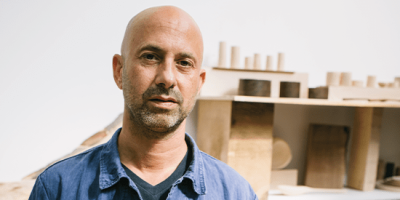

Luke Hope
Future Heritage
Information
Having spent 20 or so years in a completely different vocation, Luke Hope began his creative journey in wood in 2014. Each of his objects are skillfully carved and shaped from single pieces of wood using a combination of traditional and modern carving tools and techniques. His exquisitely crafted vessels have a strange ethereality and serenity – unusual in wood.
Luke Hope focusses on the importance of line and the interplay of light, exploring the colours and materiality of woods such as sycamore, ancient bog oak and dark walnut. Each is characterised by solid, block colours that run throughout the wood, with subtle gradations in grain lines and tone. Hope uses the properties of other materials such as a fold in fabric, a crease in a piece of paper and reinterprets them in wood to give a slightly enigmatic quality.
Luke Hope has a deep connection to the physicality of his medium; his work is often slow and contemplative, returned to and developed over time. The work reveals his finely tuned contemplation of a symbiosis, in which the natural and man-made conjoin.
At Future Heritage
Hope’s main body of work at Future Heritage 2019 featured larger vessels, both in sets and as individual pieces. Exploring the theme of translating elements found in other materials – folds, creases, crumples – into accents on the surface of the wooden vessels.
The process of creating these larger vessels was an involved and rewarding one for Hope, in the sense of taking the complete journey with the material – from source to object. This involved felling the right tree from a sustainably managed woodland in Sussex. Sectioning and then turning the heart out of the pieces, while green. Drying slowly and carefully over a few months, to avoid splitting. Then carving and shaping to create the final forms.
For the smaller pieces, Hope set out to create a group of pieces, rooted in the functional form of the spoon. ‘I wanted to play with the idea of the utilitarian form, moving into a clear object of sculpture. Stretching the form away from the ability or desire to use; a small series of abstractions,’ he explains.
Recent projects
Hope has two distinct activities within his studio practice. The first being the design and creation of tableware collections for various restaurants around the world. The second is the creation of larger, sculptural pieces, sold direct to private collectors and within exhibitions.
His restaurant projects typically involve working with creative, Michelin star chefs. Each piece is designed exclusively for them and involves collaboration around look, feel and use. It’s a process he enjoys, knowing that what he designs and creates will then go on to form part of that chef’s creative vision. The latest collection was for Esben Holmoe Bang, owner and three Michelin star chef at Maaemo, in Oslo.